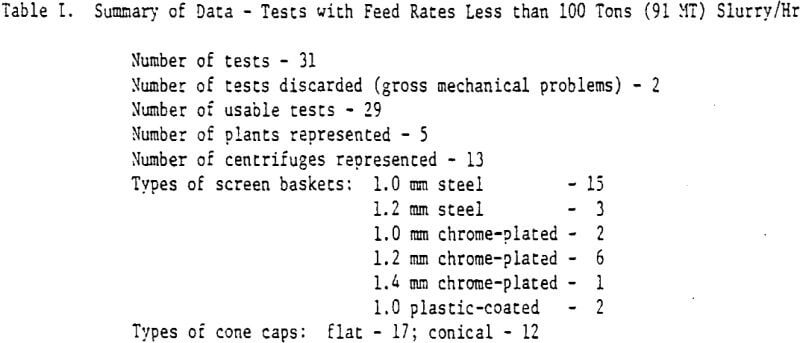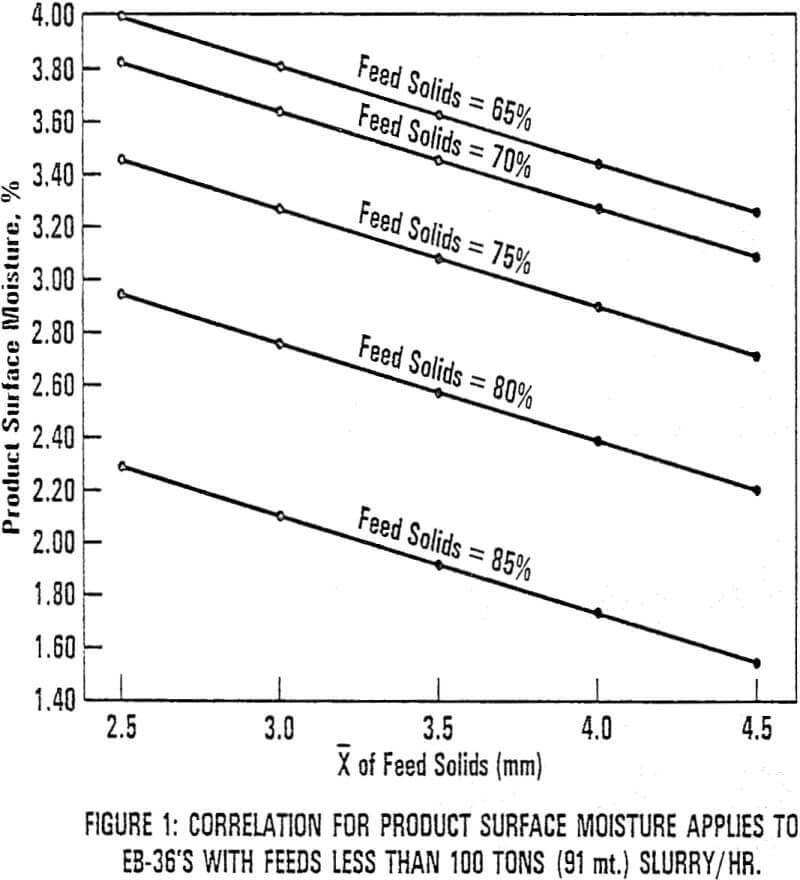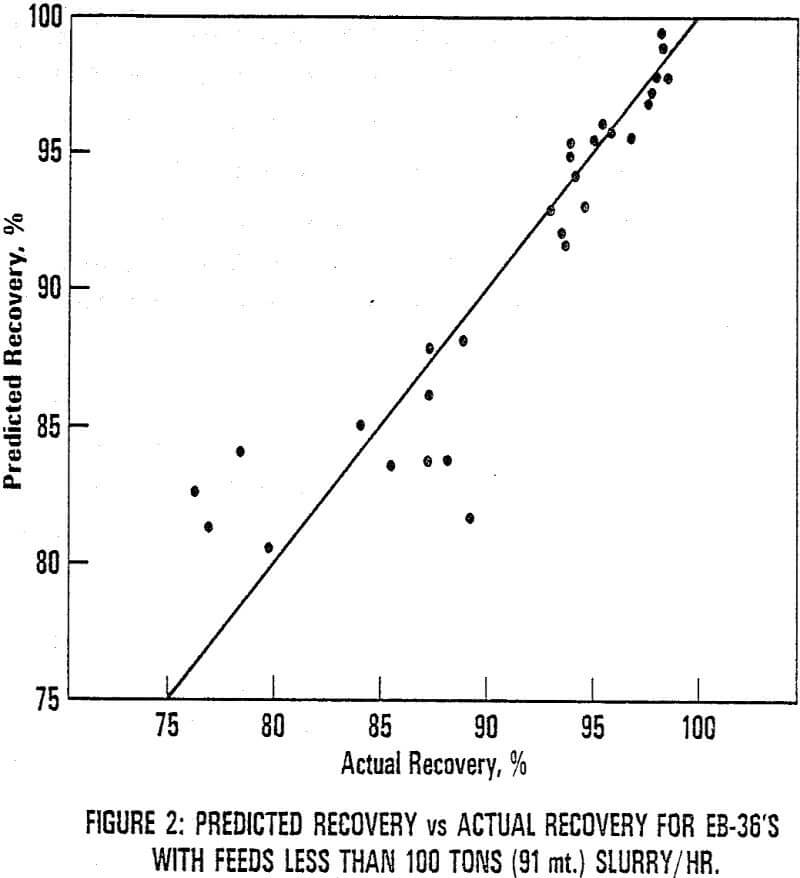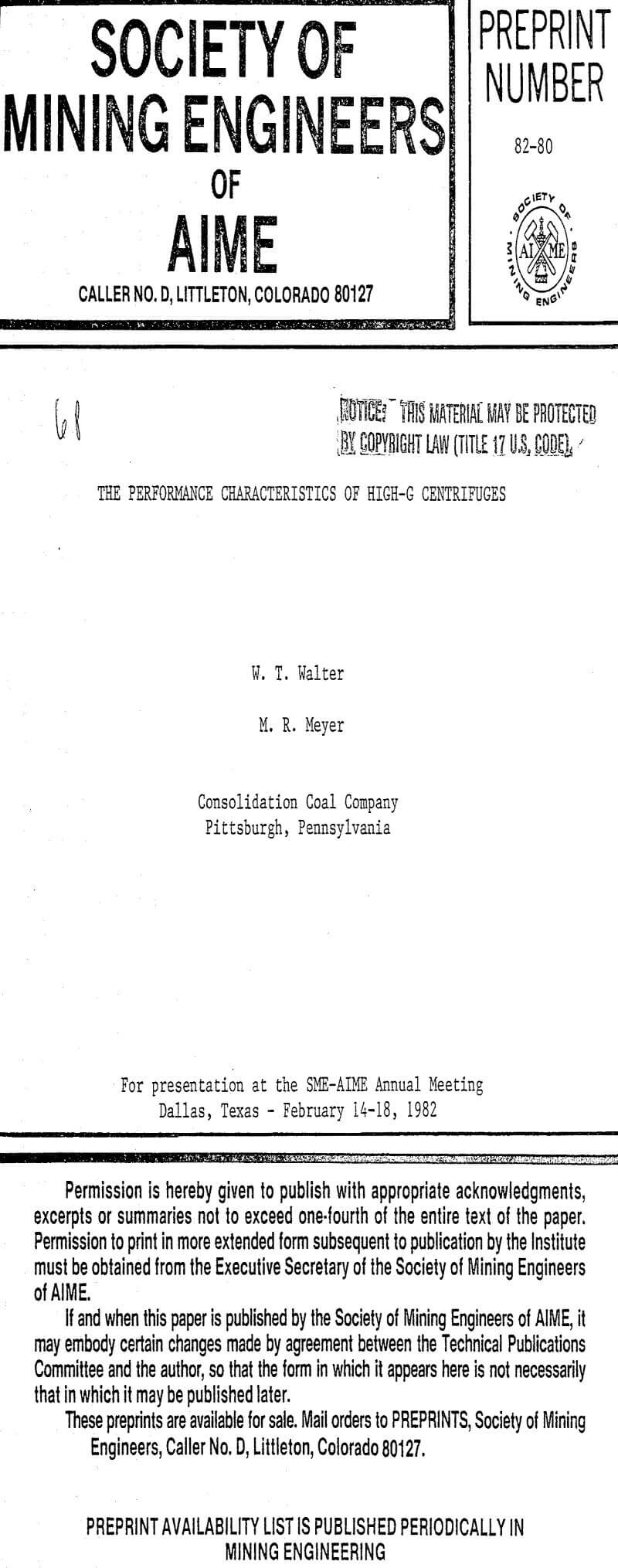Table of Contents
A great deal is known, in a qualitative sense, about the performance of High-G centrifuges. The manufacturers of these machines can give reliable guidance on the conditions necessary for the proper operation of their centrifuges and can give general estimates of the product moisture and recovery that can be expected. Quantitative estimates of the effects of changes in the various operating parameters are more difficult to find. The engineer who is faced with the problem of designing a preparation plant often may be without the specific data needed to make decisions. For example, to obtain optimum product moisture when drying 3/8″ x 28 mesh (9.5 mm x 595 microns) coal the centrifuge manufacturers recommend having no more than 5% minus 28 mesh (595 microns) material in the centrifuge feed.
Surface moistures were assumed to be equal to air-dry moistures for eastern coals (44 of the tests) and were not calculated for western coals (five of the tests). As a check for the eastern coals, the air-dry moistures were compared to (total moisture minus equilibrium moisture) and were found to match closely.
In working with the data the most crucial calculation was of recovery, since recovery is by itself an important parameter, and since the calculations of degradation and feed rate are both dependent on recovery. Recovery was calculated by moisture balance. It is also possible to calculate recovery by ash balance, but since the feed ashes and product ashes are nearly equal, the ash balance method is sensitive to small errors in ash. Degradation calculations were based on the amount of +28 mesh (595 microns) material in the feed. The amounts of +28 Mesh (595 microns) in the product and effluent were weighted by the recovery and summed, and compared to the feed. The calculation of feed rate is probably the least accurate determination in this study. Since the feed tph is derived from the effluent flow rates, the effluent percent solids and the calculated recovery, the overall error in calculating the feed tph is approximately + 15-20%.
Preliminary examination of the data showed that the three performance parameters exhibited two-tiered behavior as a function of feed rate. Oil will guarantee EB-36 performance up to the rated capacity, but they state that performance will deteriorate for higher loads. It therefore seemed appropriate to divide the data into two separate datasets, one for normal loads and one for overloads.




High-G Centrifuge Test Results Fine Coal Dewatering
Although coal cleaning reduces power-plant emissions, ash disposal costs and coal transportation costs, moisture retained from cleaning offsets some of the benefits of coal cleaning. The fine size fraction (-28 mesh), which frequently accounts for more than half of the total product’s surface moisture, can vary from 5 to 35 percent of the cleaning-plant feed. Because fine coal has more surface area per ton than coarse coal, dewatering difficulty is proportional to the amount of fine material in’ the clean coal.
High-G Centrifuge Description
Screen-bowl centrifuges were first installed in fine-coal dewatering circuits in the late 1960’s, and their use in fine-coal dewatering continues to increase. The Sharpies-Stokes Division of the Pennwalt Corporation, which also manufactures screen-bowl centrifuges, developed the high-G, solid-bowl centrifuge to achieve moistures comparable to those of the screen-bowl centrifuges while eliminating the screen drain section.
Centrifuges have long cylindrical bowls that rotate about the horizontal axes. As the incoming slurry begins to spin with the bowl and the solids are pushed to the wall by centrifugal force, the liquid, which is lighter than the solids, moves toward the axis of rotation. The solids which are pushed to the wall are moved along by a screw conveyor (scroll) which rotates slightly slower than the bowl.
This differential speed moves the solids along the tapered portion of the bowl (called the beach) and out the end of the bowl. The screen-bowl centrifuge has a screen section after’the beach that further dewaters the solids before discharge.
High-G Centrifuge Tests
The high-G centrifuge tests are based on an experimental design. Traditional tests are run changing one independent variable at a time. A factorial design approach allows the effects of a number of different factors to be evaluated by changing several factors simultaneously. Furthermore, factorial design permits the evaluation of interaction (coupling) between variables in addition to the independent effects.
Upper Freeport Seam coal from the Helen Mine in Indiana County, Pennsylvania, was crushed to ¼-in (6mm) topsize and screened at 28 mesh (0.6mm). The 28 mesh (0.6mm) x 0 fraction was cleaned in froth flotation cells and the flotation concentrate (clean coal) was collected in an agitated storage tank.
First, the agitated storage tank is decanted or diluted to the desired solids concentration. The centrifuge test then begins by feeding slurry to the centrifuge with a centrifugal pump through a magnetic flowmeter which measures flow rate.
The cake and effluent, collected during the test, are weighed (for mass balance calculations) and sent to the laboratory for analysis of Moisture (or percent solids)
Test Results
The first four columns show that the four independent operating conditions were varied as follows:

The CCTF high-G centrifuge has a variable speed D.C. back-drive that allows nearly infinite control over the differential speed between the scroll and the bowl, hence: residence time. A torque meter in the CCTF control room shows the operator when the trip torque is being approached. Furthermore, the back-drive allows the operator to clear the centrifuge on-line when a trip occurs.:









